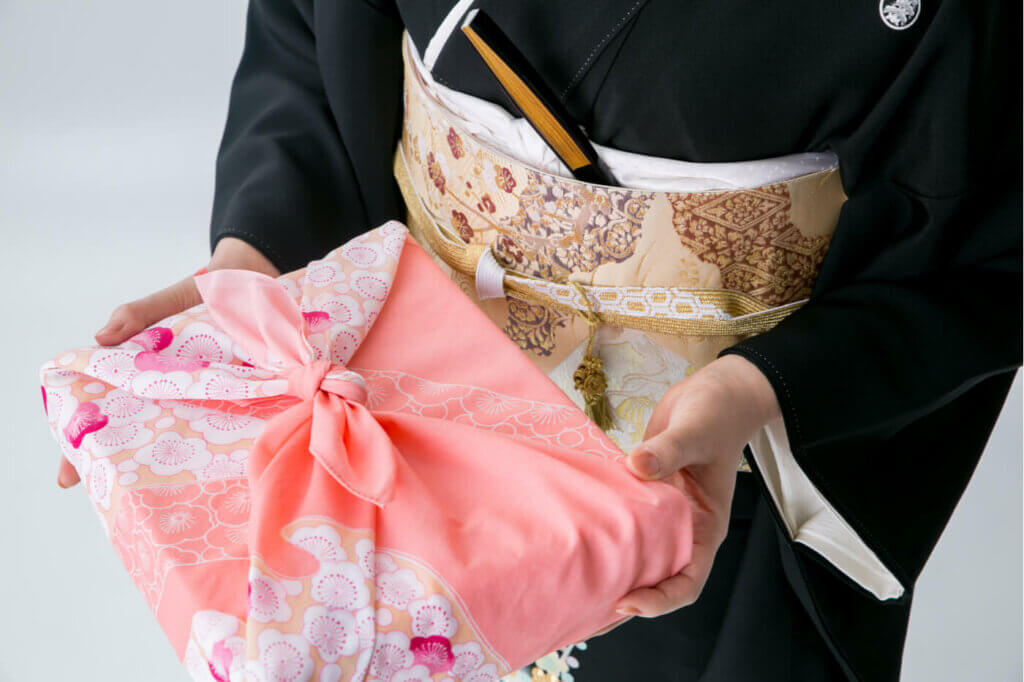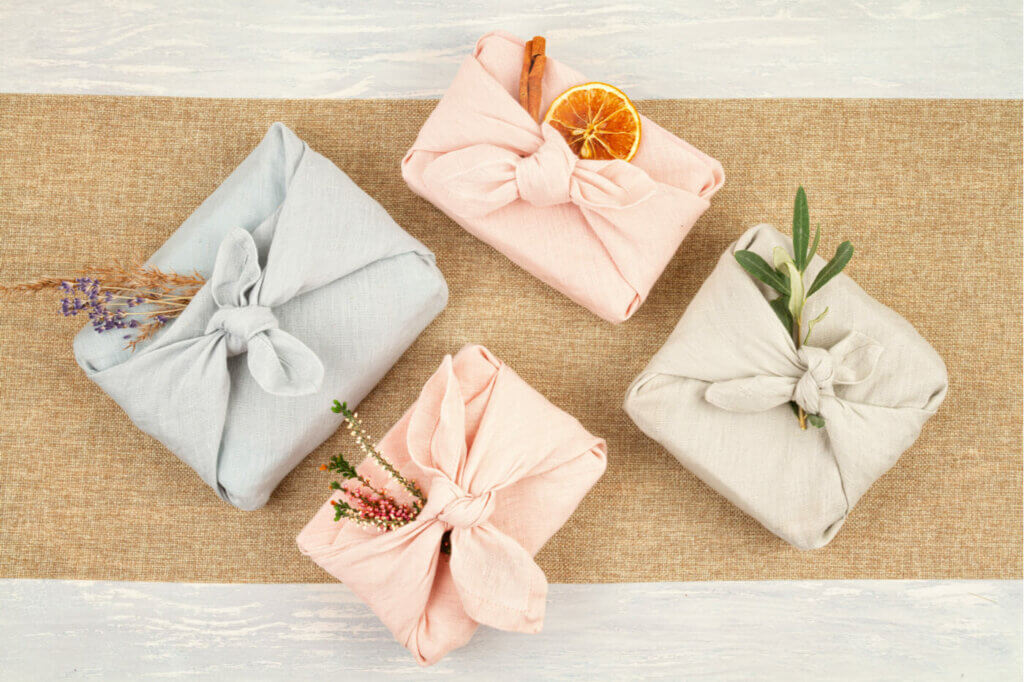Furoshiki - a Beautiful and Eco-Friendly Way To Wrap Gifts

Would you like to wrap your gifts in an original way? Try the Japanese method! The technique is called Furoshiki, and involves using fabrics instead of paper, a method that’ll make your gifts look gorgeous and that’s good for the environment at the same time.
If you want to know the keys to giving your gifts a personal and attractive touch, check out these tips. You’ll fall in love with this technique!
Everything you need to know about Furoshiki

Thanks to the Japanese ambassador of tidiness, Marie Kondo, many people have heard about this and other techniques the Japanese use to organize everything and create more attractive living spaces. Furoshiki has its origins in the eighth century, during the Nara period (710 – 794). It’s a combination of the two words “furo” and “shiki”, meaning “bath” and “to spread” respectively.
“Furo“, are traditional Japanese baths, where a cloth was spread on the floor for customers to leave their clothes so as not to confuse them with other people’s. Eventually, these cloths evolved into a kind of wrapper to carry a change of clothes and toiletries, like a toiletry bag.
As a consequence, Furoshiki became a widespread way to carry belongings from one place to another.
Furoshiki were also used at weddings, and the cloths had designs of birds, fans, waves, etc., symbolizing happiness and good fortune. This way of wrapping things was passed down from generation to generation until it became an indispensable tool in the life of the Japanese.
Furoshiki is back in fashion
Over time, the technique fell out of favor, especially with the arrival of plastic bags from the West. Fortunately, the Japanese government began to promote it again as an action to protect the environment.
That was in 2006, when Japan’s environment minister Yuriko Koike created a fabric with the aim of encouraging use of the traditional technique. At the same time, she started a campaign called “Mottainai Furoshiki” to raise awareness and increase its use.
What does the technique consist of?
The most common fabrics used in Furoshiki to wrap gifts are silk, cotton, rayon and nylon, although in reality you can use any flexible fabric.
In Japan, the size of the fabric varies depending on the object to be wrapped, but as a rough guide you’ll need about a yard of fabric for an object of 8 inches.
Some ways to use Furoshiki to wrap gifts
The technique for making a Furoshiki to wrap gifts is quite simple. It consists of folding and tying the square of fabric following the basic principles of origami. Each way of doing it has its own name and a different purpose. Here are a few examples:
- Bin-zutsumi: ideal for wrapping a bottle.
- Hikkake-zutsumi: recommended for wrapping a box or a long container.
- Hirazutsumi: this shape is more suitable for a square or rectangular box.
- Kakushi-zutsumi: also used for a square or rectangular box, but with a hidden knot.
- Maki-zutsumi: for wrapping long or cylindrical objects.
- Otsukai-zutsumi: for square or rectangular objects, with a visible knot.
- Suika-zutsumi: another way to wrap and transport a round object.
A beautiful and ecological technique
There are lots of ways to take care of the environment – how you consume and recycle, the type of materials you use… and also the way you wrap your Christmas gifts. Think about it!
Usually, you go to the stationery store and buy the paper, a decoration, tape, etc. The problem is that all these materials end up in a trash can and contribute to polluting the planet.
But the Japanese have a technique that’s both sustainable and that will surprise everyone who receives a gift wrapped in fabric.
You can practice with some of the tutorials available on the web, such as this one on LifeHacker, where they teach basic wrap for beginners.
You’ll see that there are endless uses for fabric. Find some pieces at home or buy them – stores often have leftover pieces at very good prices.
Would you like to wrap your gifts in an original way? Try the Japanese method! The technique is called Furoshiki, and involves using fabrics instead of paper, a method that’ll make your gifts look gorgeous and that’s good for the environment at the same time.
If you want to know the keys to giving your gifts a personal and attractive touch, check out these tips. You’ll fall in love with this technique!
Everything you need to know about Furoshiki

Thanks to the Japanese ambassador of tidiness, Marie Kondo, many people have heard about this and other techniques the Japanese use to organize everything and create more attractive living spaces. Furoshiki has its origins in the eighth century, during the Nara period (710 – 794). It’s a combination of the two words “furo” and “shiki”, meaning “bath” and “to spread” respectively.
“Furo“, are traditional Japanese baths, where a cloth was spread on the floor for customers to leave their clothes so as not to confuse them with other people’s. Eventually, these cloths evolved into a kind of wrapper to carry a change of clothes and toiletries, like a toiletry bag.
As a consequence, Furoshiki became a widespread way to carry belongings from one place to another.
Furoshiki were also used at weddings, and the cloths had designs of birds, fans, waves, etc., symbolizing happiness and good fortune. This way of wrapping things was passed down from generation to generation until it became an indispensable tool in the life of the Japanese.
Furoshiki is back in fashion
Over time, the technique fell out of favor, especially with the arrival of plastic bags from the West. Fortunately, the Japanese government began to promote it again as an action to protect the environment.
That was in 2006, when Japan’s environment minister Yuriko Koike created a fabric with the aim of encouraging use of the traditional technique. At the same time, she started a campaign called “Mottainai Furoshiki” to raise awareness and increase its use.
What does the technique consist of?
The most common fabrics used in Furoshiki to wrap gifts are silk, cotton, rayon and nylon, although in reality you can use any flexible fabric.
In Japan, the size of the fabric varies depending on the object to be wrapped, but as a rough guide you’ll need about a yard of fabric for an object of 8 inches.
Some ways to use Furoshiki to wrap gifts
The technique for making a Furoshiki to wrap gifts is quite simple. It consists of folding and tying the square of fabric following the basic principles of origami. Each way of doing it has its own name and a different purpose. Here are a few examples:
- Bin-zutsumi: ideal for wrapping a bottle.
- Hikkake-zutsumi: recommended for wrapping a box or a long container.
- Hirazutsumi: this shape is more suitable for a square or rectangular box.
- Kakushi-zutsumi: also used for a square or rectangular box, but with a hidden knot.
- Maki-zutsumi: for wrapping long or cylindrical objects.
- Otsukai-zutsumi: for square or rectangular objects, with a visible knot.
- Suika-zutsumi: another way to wrap and transport a round object.
A beautiful and ecological technique
There are lots of ways to take care of the environment – how you consume and recycle, the type of materials you use… and also the way you wrap your Christmas gifts. Think about it!
Usually, you go to the stationery store and buy the paper, a decoration, tape, etc. The problem is that all these materials end up in a trash can and contribute to polluting the planet.
But the Japanese have a technique that’s both sustainable and that will surprise everyone who receives a gift wrapped in fabric.
You can practice with some of the tutorials available on the web, such as this one on LifeHacker, where they teach basic wrap for beginners.
You’ll see that there are endless uses for fabric. Find some pieces at home or buy them – stores often have leftover pieces at very good prices.







